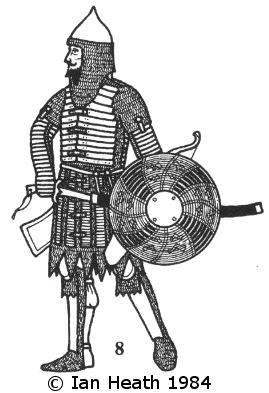
Create an Amazon Wedding Registry
OTTOMAN HEAVY INFANTRYMAN
An extract from Armies of the Middle Ages, Volume 2by Ian Heath



8. OTTOMAN HEAVY INFANTRYMAN
As has already been mentioned under figure 3, it is clear from many contemporary accounts that a proportion of the infantry in most Ottoman armies were armoured, and it seems highly probable that the majority of such heavy infantry was comprised of regular troops, i.e. the Janissaries and other elements of the Qapu Khalqi. H. Russell Robinson actually suggests in his Oriental Armour that the mail and plate corselet of this figure (called a korazin) may have actually been that of a 15th century Janissary officer; certainly it was that of an infantryman since its skirt is not split for riding, and its completeness leaving only his face, fingertips and the backs of his legs unprotected is exceptional enough to make it improbable that it was worn by an ordinary soldier, who would probably have lacked either the budluks (leg-armour) or the kolluks or bazubands (vambraces), possibly both; certainly the ‘Ordo Portae’ states that although the cavalry wore leg-harness, the infantry did not. His helmet is probably an early missiourka, most popular in the Ottomans’ western provinces and, by the 16th century, in Russia, Hungary and Poland too; in the 16th century the Turks usually wore it over a turban, and this may have been 15th century practice too.
In his ‘Travels’ of 1432-33 Brocquière wrote of the Ottomans that ‘I have seen them wear very handsome coats of armour like ours, except that the links of the mail are smaller; the vambraces were the same [as those used in Western Europe; for the variant type of bazuband to which Brocquière is referring see figure 26] … Their armour descends almost half-way down the thigh, but a piece of silken stuff is attached circularly to the bottom of it, that falls down to the calf of the leg.’ That all this was clearly visible means that armour was not worn under a coat or tunic as has often been suggested. From what Brocquière says next it is clear that he is describing Janissaries: ‘On their heads they wear a round white cap, half a foot[?] high, terminated in a point. It is ornamented with plates of iron on all sides, to ward sword-blows off from the face, neck and cheeks, and is like the helmets of France called sallets.’ He adds that they usually also wore ‘a bonnet of iron wire’ with it, doubtless meaning a mail hood. That the Janissaries wore their tall white caps over their helmets in battle is confirmed by repeated references in contemporary sources.
Giacomo Tetaldi, who was present, says that at the siege of Constantinople in 1453 about a quarter of the Ottomans wore some sort of armour, either hauberks or leather jacks, a few even wearing French or Hungarian styles of armour. The ‘leather jacks’ are doubtless kazaghands, seemingly popular in this period even though no Turkish examples have survived (for a Mamluk example see figure 18).